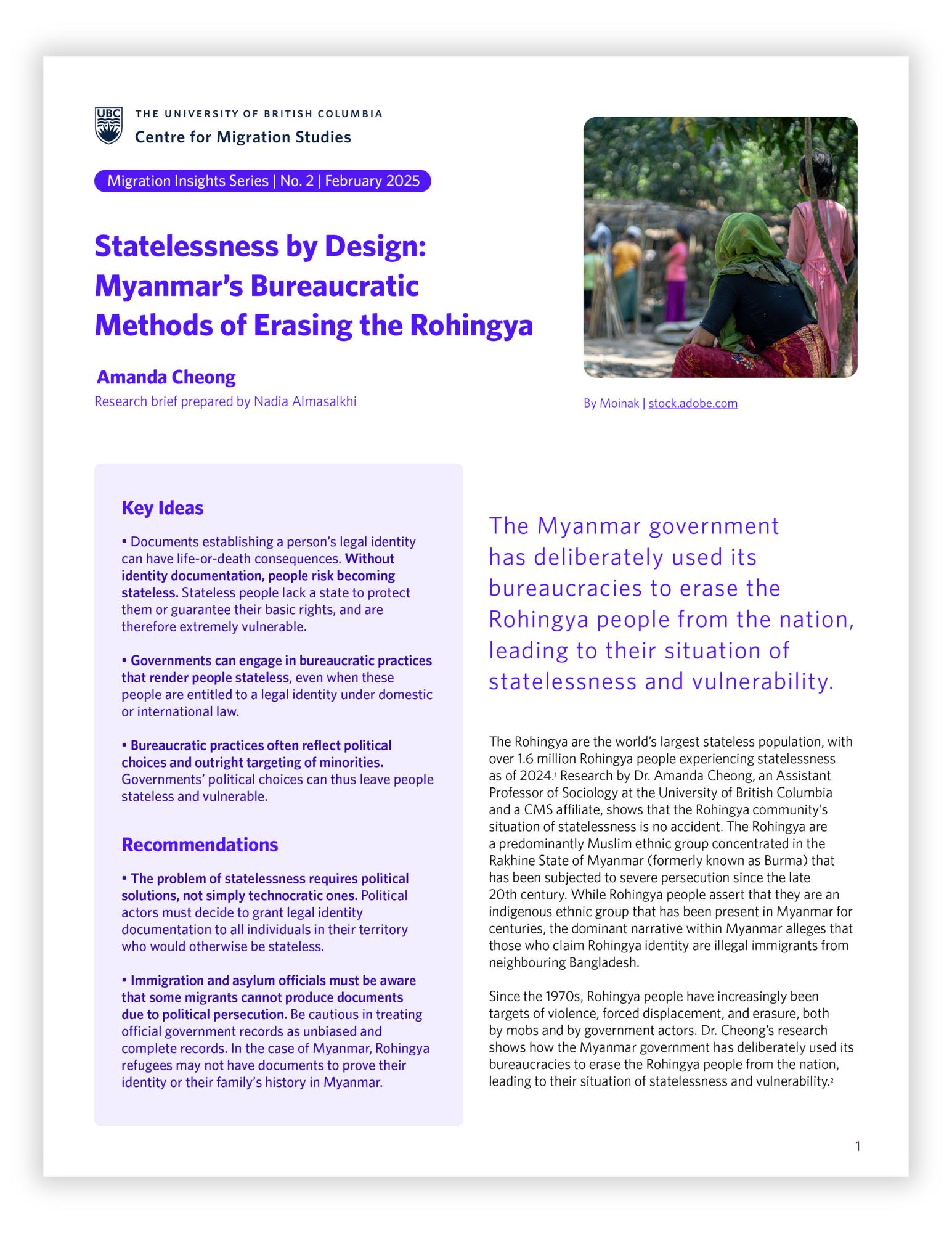Bureaucracies that “fail” to document every citizen may be deliberately creating statelessness.
Four years ago, on February 18, 2021, Canada imposed sanctions on Myanmar after a military coup removed elected civilian leaders from the government. Under both military and civilian rule, though, the state of Myanmar took deliberate steps to create the largest stateless population in the world. Research by CMS affiliate Dr. Amanda Cheong shows how Myanmar used its state bureaucracies to erase the Rohingya ethnic group from the nation—with dire consequences.
“It’s not an accident that some people have birth certificates and IDs while others don’t.”
Key Findings
-
Documents establishing a person’s legal identity can have life-or-death consequences. Without identity documentation, people risk becoming stateless. Stateless people lack a state to protect them or guarantee their basic rights, and are therefore extremely vulnerable.
-
Governments can engage in bureaucratic practices that render people stateless, even when these people are entitled to a legal identity under domestic or international law.
-
Bureaucratic practices often reflect political choices and outright targeting of minorities. Governments’ political choices can thus leave people stateless and vulnerable.
Recommendations
-
The problem of statelessness requires political solutions, not simply technocratic ones. Political actors must decide to grant legal identity documentation to all individuals in their territory who would otherwise be stateless.
-
Immigration and asylum officials must be aware that some migrants cannot produce documents due to political persecution. Be cautious in treating official government records as unbiased and complete records. In the case of Myanmar, Rohingya refugees may not have documents to prove their identity or their family’s history in Myanmar.
Implications for Current Events
Worldwide, there are between 4.4 million and 10 million stateless people. The elimination of statelessness is part of the United Nations Sustainable Development Goals for 2030. Unfortunately, there has been little evidence of progress towards reducing or preventing statelessness since the Sustainable Development Goals were adopted in 2015. While UN reports lament the incompleteness of most countries’ birth registration systems and censuses, they tend to treat these omissions as resulting from bureaucratic weakness, such as a lack of investment in national data collection systems. Their proposed solutions advocate for strengthening national statistical systems and “embracing innovation” and advanced technology.
Dr. Amanda Cheong’s research shows, however, that political will, not technocratic or high-tech solutions, is what is required to achieve an end to statelessness. Although some states do lack institutional capacity to conduct complete censuses and maintain accurate vital statistics, the largest stateless population in the world–the Rohingya from Myanmar–are stateless because Myanmar used their state institutional capacity to revoke and downgrade Rohingyas’ identity documents and to systematically exclude Rohingyas from the national census. The statelessness of the Rohingya community is further exacerbated by the political decisions of neighbouring countries. These host countries refuse to legally recognize displaced Rohingyas as “refugees” and refuse to provide them with identity documentation. Without relief from statelessness, displaced Rohingyas remain restricted from accessing basic rights, like freedom of movement, livelihood, and education. The case of the Rohingya illustrates how eliminating statelessness requires political change in addition to institutional development.
About the Authors
Amanda Cheong is an Assistant Professor of Sociology at the University of British Columbia. Her research focuses on how legal status and documents shape people’s lives, particularly in Southeast Asia and in North America. Her research has been published in peer-reviewed journals like International Migration Review, Social Problems, and Ethnic and Racial Studies. She is currently writing a book about the experiences of stateless individuals in Malaysia. She earned her BA at the University of British Columbia and her PhD at Princeton University.
Nadia Almasalkhi is a doctoral candidate in Sociology at the University of California, Berkeley. She is a National Science Foundation Graduate Research Fellow. She holds two BA degrees from the University of Kentucky and an MA degree from the University of California, Berkeley. Her current research studies the political integration and political transnationalism of Middle Eastern immigrants and diasporas, especially from Syria and Lebanon.
Copyright: UBC Centre for Migration Studies
Availability: Web & Print
Publication date: February 18, 2025
Pages: 3
This publication is part of the CMS Migration Insights Series. The research briefs synthesize peer-reviewed, published academic research by CMS affiliates.
